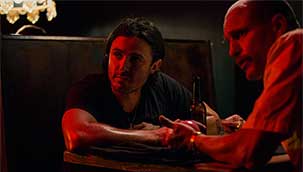The first time I ever wondered how the fuck did they do that without someone dying was while watching The French Connection—William Friedkin’s gritty thriller about 70’s New York cops and their intersection with the heroin trade. The scene in question involves Popeye Doyle (played pitch perfectly by Gene Hackman) careening down Stilwell Avenue in Brooklyn, chasing a hijacked L train, while driving (insanely fast) in a commandeered Pontiac. It is, arguably, the most intense scene of its kind ever filmed.
Triple 9 had more than a few of those kinds of moments. There were two extended car scenes that were phenomenally well crafted, and the rest of the film incorporated the kind of practical effects that make this kind of crime thriller grounded and pleasingly retro. Triple 9 begins with a tautly choreographed heist that culminates in an insane chase onto a crowded Atlanta overpass. And your work shone through. In the same way that the above mentioned scene in The French Connection completely immerses the audience in the moment—through sharp edits, great camerawork and most importantly, skilful and often dangerous stunt work—so too does Triple 9.
The rest of the film, specifically the parts where people speak, is more uneven. Director John Hillcoat has made a couple of great films—The Road and The Proposition—and a near miss, Lawless. Triple 9 is more the latter than the former but it also suffers from a genre fatigue that particularly afflicts crime thrillers. Films like Triple 9 are (fairly or not) often held up in comparison to The French Connection or Michael Mann’s Heat or even something like Live and Die in LA—another Friedkin film and the one Triple 9 most closely resembles.
Part of the reason for this kind of close reading vs. what came earlier is that films like Triple 9 have a very specific pedigree: urban, often morally ambiguous, and deeply connected with whatever city it’s located in (this time a very well articulated Atlanta cityscape). Triple 9 is also filled with a kind of retrograde masculinity that is both compelling and weirdly out of time. This feels like a film that easily could have been made in the early seventies—which raises the bar substantially. Sometimes Triple 9 meets that gold standard, and sometimes it doesn’t.
This version of Atlanta is a seedy place, populated by authority figures that are only differentiated from the criminals by their institutional veneer. That moral greyness is multiplied by a whole slew of shifting loyalties that, unfortunately, also slow the film down. Still, Triple 9 has some great performances (Chiwetel Ejiofor, Luis Da Silva and Kate Winslet in particular), remarkable atmosphere, and a few tension filled set pieces. It just never really coheres as a narrative; there are just too many plot threads, especially for a genre that thrives best when it is laser sharp in its focus.
Triple 9 does have more than a few memorable scenes though, even if all of them are kinetic and mostly dialogue free—including Casey Affleck leading a SWAT team in a breach. There is a Silence of The Lambs night-vision-in-the-basement-tension to it that is completely effective. And it is in these moments that the film works best.
You certainly helped make those parts of the film thrum with a real threat and menace, Mickey, and because of that Triple 9 rises above the crowd. But just barely.
Sincerely,

Tim







